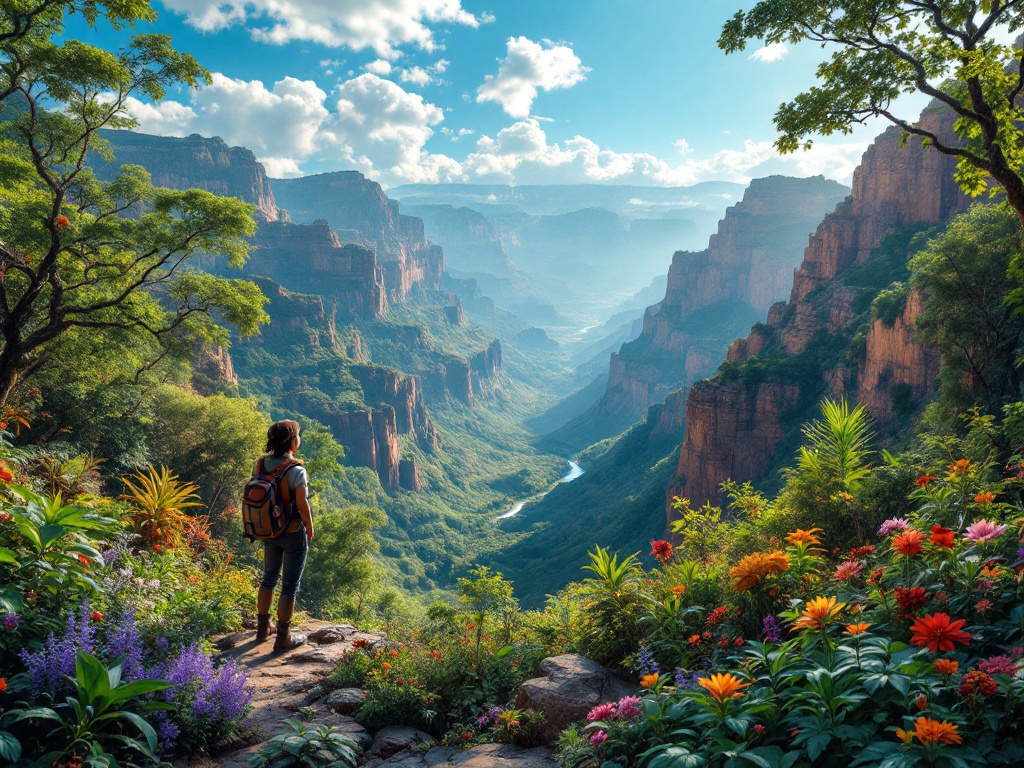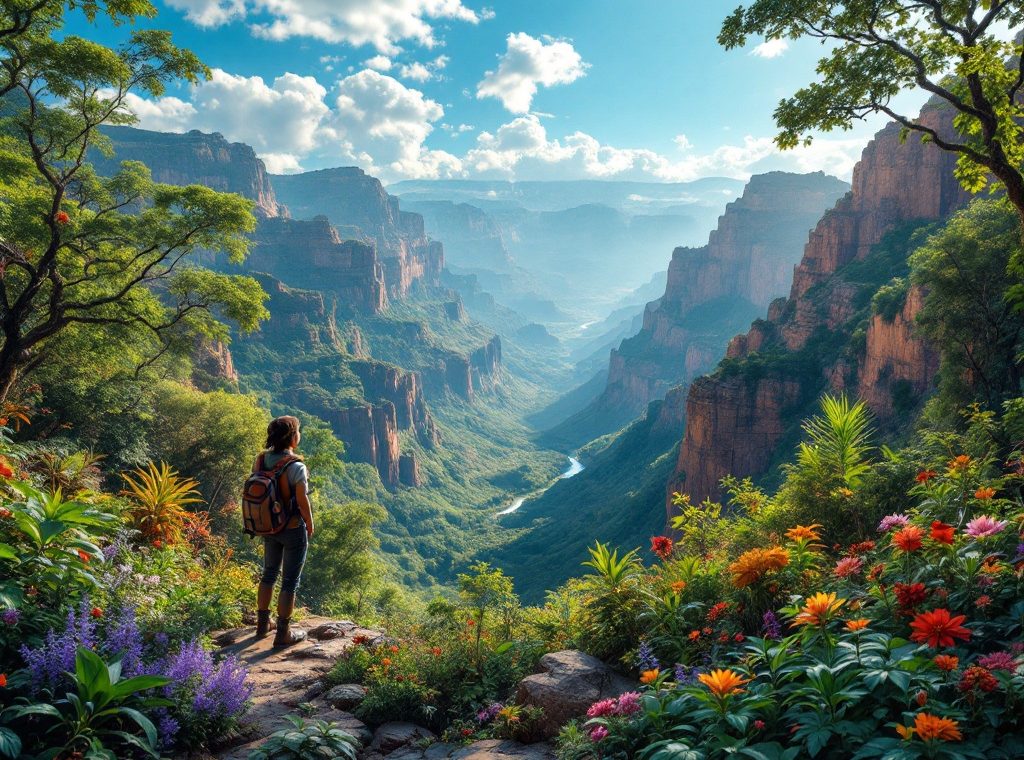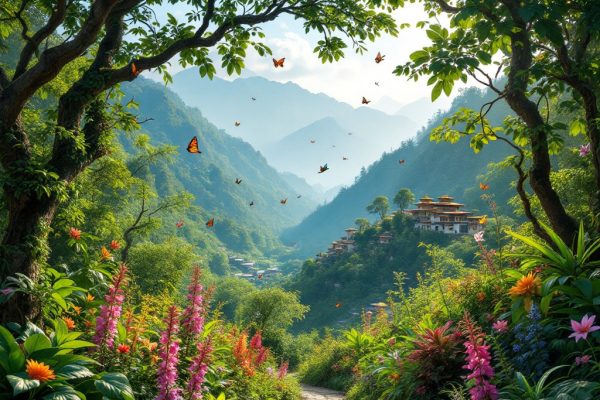Natural Wonders with Scientific Significance: A Traveler’s Guide
Unlock the secrets of Earth’s interconnected life! Explore natural wonders, from the Amazon Rainforest to the Grand Canyon, and discover their vital role in scientific advancement. Learn how these sites enhance our understanding of geology, ecology, and climate change, contributing to crucial conservation efforts. Dive into this exploration of Earth’s most remarkable landscapes and be inspired to protect our planet’s future.
Important information

- Natural wonders offer key insights into geology, ecology, and climate change, helping us understand Earth’s history and biodiversity.
- The Amazon Rainforest, Grand Canyon, Yellowstone, Great Barrier Reef, and Antarctica are crucial sites for research on biodiversity, geological processes, climate change, and marine biology.
- Glaciers reveal climate change effects and waterfalls demonstrate powerful erosion, shaping landscapes and supporting unique ecosystems.
- Forests and coastal areas are vital for biodiversity, climate regulation, and ecosystem services like storm protection and pollutant filtering.
- Indigenous knowledge offers valuable insights into sustainable living and conservation, emphasizing the interconnectedness of life.
Understanding the Scientific Significance
Earth’s natural wonders unlock secrets about our planet’s interconnected life, offering invaluable insights for scientific discovery. These remarkable sites enhance our understanding of geology, ecology, and climate change. Research conducted in these living laboratories unveils Earth’s history, its biodiversity, and the impact of environmental shifts. Scientists explore ecological interactions, geological formations, and unique phenomena, leading to improved conservation efforts and sustainable practices. Ultimately, these natural wonders are crucial for safeguarding our planet’s future.
Ecological Significance and Interconnectedness
Ecological significance reveals the intricate connections between species and their environment, forming a complex web of life. Protecting natural landscapes is crucial for maintaining this delicate balance. Scientific significance highlights how these interactions influence planetary health and the broader Earth systems.
The Importance of Forest and Coastal Biodiversity
Forest biodiversity plays a vital role in stabilizing ecosystems, cycling nutrients, and regulating our climate. These habitats support a wide variety of species, ranging from insects and fungi to birds and mammals. Forests also serve as sources of food, medicine, and raw materials, offering recreational opportunities.
Coastal regions are equally important for biodiversity, fostering unique ecosystems such as mangroves, salt marshes, and coral reefs. These coastal habitats provide crucial protection against storms, act as nurseries for fish, and filter pollutants. They also contribute to global biodiversity and offer essential ecosystem services.
Desert Landscapes and Their Unique Ecosystems
Desert ecosystems are remarkable for the ingenious ways plants and animals adapt to survive. Cacti, for instance, store water in their stems, while nocturnal animals escape the intense daytime heat. Survival, however, depends on more than individual adaptations. Intricate symbiotic relationships play a crucial role. These vital partnerships enable organisms to thrive in the harsh desert environment, contributing to the ecosystem’s overall health and stability.
Iconic Natural Wonders with Scientific Significance
Natural wonders offer more than just scenic beauty; they are crucial for scientific advancement. The Amazon Rainforest, a hub of biodiversity, is essential for climate change research, complemented by the vital role of the Amazon River. Geological formations like the Grand Canyon and Yellowstone National Park provide unique insights into Earth’s processes, with Yellowstone showcasing geothermal activity. Marine ecosystems, such as the Great Barrier Reef, are equally vital for marine biology research and understanding climate change impacts. Furthermore, polar regions like Antarctica are critical for climate research, while the breathtaking Aurora Borealis contributes to atmospheric studies. These iconic locations offer invaluable opportunities to deepen our understanding of Earth’s intricate systems. Protecting these unique sites is essential for future research and the benefit of generations to come.
Natural Wonders and their Scientific Importance
The Amazon Rainforest: a hub of biodiversity, essential for climate change research, supported by the Amazon River.
Geological Formations: the Grand Canyon and Yellowstone National Park offer insights into Earth’s processes, with Yellowstone’s geothermal activity being a key research area.
Marine Ecosystems: the Great Barrier Reef is vital for marine biology research and understanding climate change impacts.
Polar Regions and Atmospheric Phenomena: Antarctica is critical for climate research, and the Aurora Borealis contributes to atmospheric studies.
Protecting these unique sites is essential for future research and the benefit of generations to come.
Amazon Rainforest and River
The Amazon Rainforest, located in South America, is the world’s largest rainforest. It plays a vital role in regulating Earth’s climate and harboring incredible biodiversity. Its lifeblood, the Amazon River, is the world’s largest river by volume. It supports a rich aquatic ecosystem and influences regional weather patterns. Together, the rainforest and river form a complex, interconnected system crucial for both scientific research and conservation efforts.
Geological Formations: Grand Canyon and Yellowstone
The Grand Canyon, a true geological marvel carved by the Colorado River, reveals a story told in layers of rock spanning millions of years. Yellowstone National Park presents another natural wonder, a geothermal wonderland where geysers like Old Faithful erupt with scalding water and hot springs. The Grand Prismatic Spring shimmers with vibrant colors. These geothermal features highlight Yellowstone’s volcanic activity and unique hydrothermal processes.
Grand Canyon
Carved by the Colorado River, revealing millions of years of geological history.
Yellowstone National Park
A geothermal wonderland featuring geysers like Old Faithful and colorful hot springs such as the Grand Prismatic Spring, showcasing volcanic activity and hydrothermal processes.
Marine Ecosystems: Great Barrier Reef
The Great Barrier Reef, a vibrant tapestry of life, is the world’s largest coral reef system. It comprises over 2,900 individual reefs and 900 islands, forming an interconnected ecosystem crucial for ocean health. This remarkable reef supports astounding biodiversity, including over 1,500 fish species, 411 types of hard coral, and an astonishing one-third of the planet’s soft corals.
Polar Regions: Antarctica and Aurora Borealis
Antarctica, Earth’s southernmost continent, plays a crucial role in regulating global temperatures, making it vital for our planet’s climate. Beyond its climatic significance, Antarctica offers a spectacular light show: the Aurora Australis, or Southern Lights. Similar to the Northern Lights, this phenomenon arises from charged solar particles interacting with Earth’s magnetic field, creating vibrant colors that dance across the night sky. This breathtaking display is a unique and natural wonder of the Antarctic region.
Unique Global Landscapes
Yellowstone’s Grand Prismatic Spring dazzles with a rainbow of colors, a vibrant display created by heat-loving bacteria.
Mexico’s Parícutin Volcano rises as a classic cinder cone.
The desert canyons of Antelope Canyon, Arizona, and Wadi Rum, Jordan, showcase stunning rock formations sculpted by erosion.
Turkey’s Meke Crater Lake, a maar lake, offers a glimpse into the explosive power of a phreatomagmatic eruption.
Geothermal Features: Grand Prismatic Spring
Yellowstone’s Grand Prismatic Spring is a massive hot spring, boasting stunning, vibrant colors. These hues originate from microbial mats teeming with heat-loving bacteria that thrive in the mineral-rich water. The water temperature fluctuates significantly, reaching 160°F at the center but cooling to 120°F along the edges.
Desert Canyons: Antelope Canyon and Wadi Rum
Arizona’s Antelope Canyon
Arizona’s Antelope Canyon captivates with narrow slot canyons sculpted by water erosion.
Jordan’s Wadi Rum
Wadi Rum presents a contrasting desert panorama, a protected area showcasing towering sandstone mountains and distinctive rock formations, including the Burdah Rock Bridge and the Seven Pillars of Wisdom.
These breathtaking landscapes demonstrate the potent forces of erosion and the remarkable endurance of desert life.
Volcanism and Craters: Paricutin Volcano, Meke Crater Lake
Mexico’s Parícutin Volcano, a remarkable cinder cone, erupted from 1943 to 1952. This eruption offered scientists the rare chance to witness a volcano’s complete life cycle.
Turkey’s Meke Crater Lake (Meke Gölü) presents another volcanic marvel. Formed by volcanic activity, this crater lake showcases the interaction between volcanic landscapes and water, resulting in unique ecosystems.
Exploring Natural Phenomena
Glaciers and ice fields serve as archives of Earth’s climate history, revealing the stark realities of global warming. These frozen landscapes also support unique ecosystems and showcase fascinating geological formations. Waterfalls, such as Victoria, Niagara, and Iguazu Falls, carve the land through erosion, demonstrating their power as natural forces. These cascades also nurture life, supporting local ecosystems and boosting biodiversity. Witnessing these natural wonders deepens our understanding of Earth’s dynamic processes, from the force of erosion to the delicate balance of ecosystems. Experiencing these wonders inspires awe and fosters a deeper appreciation for our planet’s beauty and power.
Witnessing Glaciers and Icy Realms
Witnessing a glacier firsthand powerfully demonstrates the effects of climate change. These immense ice formations, found in areas such as Alaska, Patagonia, and the Himalayas, serve as vital indicators of global warming, continuously transforming their surroundings. A journey through these icy landscapes inspires awe while revealing the crucial role glaciers play in Earth’s delicate balance. Though magnificent, glaciers are also highly vulnerable to rising temperatures, melting at alarming rates and contributing to rising sea levels and disrupting ecosystems. Visiting these icy giants provides a profound and sobering understanding of our planet’s beauty and fragility, emphasizing the urgent need for climate action.
The Power and Beauty of Waterfalls
Waterfalls are stunning displays of water’s raw power, carving canyons and reshaping landscapes over eons. These captivating natural wonders also foster unique micro-habitats, supporting diverse plants and animals. The mist they create nourishes lush vegetation, further enriching the local biodiversity.
Ecotourism and Traveler’s Guide
National parks, such as Yellowstone and the Galapagos, protect biodiversity and crucial natural resources. These protected areas offer educational and recreational opportunities while preserving vital ecosystems. Visitors play a crucial role in conservation by adhering to park regulations and Leave No Trace principles.
Wildlife encounters, like whale watching or jungle treks, provide incredible opportunities to observe animals in their natural habitats. Responsible interaction is paramount, minimizing disturbances and prioritizing animal welfare. Choosing reputable tour operators supports these conservation efforts.
Indigenous communities possess a profound understanding of their environment. From traditional land management in the Amazon to Aboriginal knowledge in Australia, engaging with these cultures offers invaluable insights into sustainable living and conservation. Supporting community-based tourism respects cultural heritage while empowering local people.
National Parks and Protected Areas
National parks safeguard biodiversity and vital ecosystems, providing exceptional ecotourism and educational experiences. Yellowstone and Yosemite, renowned for their unique geological formations, draw visitors worldwide. The Grand Canyon, another prominent example, showcases the magnificence of nature. These sanctuaries preserve crucial habitats for endangered species, contributing significantly to their survival.
Wildlife Encounters and Biodiversity Exploration
Wildlife encounters offer unforgettable connections with diverse animal species, fostering conservation awareness. Observing animals in their natural environments illuminates the intricate workings of ecosystems. Whale watching, birdwatching tours, and safaris provide invaluable learning experiences that enrich scientific knowledge. Researchers gain insights into animal behavior, distribution, and ecological roles. Moreover, these encounters underscore the significance of biodiversity and the urgent need to safeguard wildlife from existing threats. Protecting these animals is essential for maintaining the balance of nature.
Indigenous Ecological Wisdom
Indigenous ecological knowledge reveals the interconnectedness of all living things. This traditional wisdom emphasizes sustainable practices, such as the controlled burns used by Aboriginal Australians and the agroforestry techniques of Amazonian tribes. These methods improve both biodiversity and ecosystem health. Indigenous communities have a deep understanding of local species and their uses, which is essential for discovering medicinal plants and promoting sustainable resource management.













